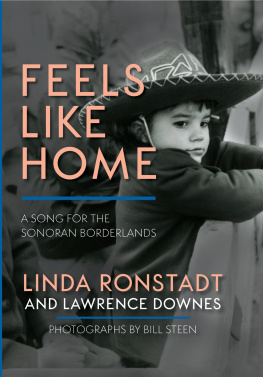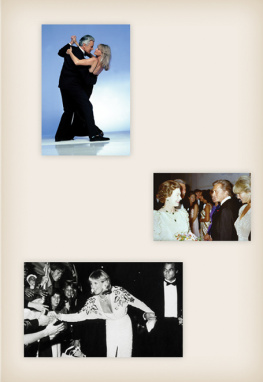Contents
Guide

Front endsheet: View of the Ro Sonora Valley from above the town of Bavicora, Sonora.
Back endsheet: Besides Criollo cattle, 47 Ranch also raises sheep for wool.
Copyright 2022 by Linda Ronstadt, Lawrence Downes, and Bill Steen
All rights reserved. No portion of this work may be reproduced or transmitted in any form or by any means, electronic or mechanical, including photocopying and recording, or by any information storage or retrieval system, without permission in writing from Heyday.
constitutes an extension of this copyright page.
Library of Congress Cataloging-in-Publication Data
Names: Ronstadt, Linda, author. | Downes, Lawrence, author. | Steen, Bill, photographer.
Title: Feels like home : a song for the Sonoran borderlands / by Linda Ronstadt and Lawrence Downes, photographs by Bill Steen.
Description: Berkeley, California : Heyday, [2022] | Where the water turns -- Desert people -- Margaritas letters -- Mi pueblo -- A love story -- La frontera -- The mission garden -- Canelo diary -- Desert cattle -- El futuro -- Coda: my dream
Identifiers: LCCN 2021060716 (print) | LCCN 2021060717 (ebook) | ISBN 9781597145794 (hardcover) | ISBN 1597145793 (hardcover) | ISBN 9781597145800 (epub)
Subjects: LCSH: Ronstadt, Linda. | Singers--United States--Biography. | Mexican-American Border Region--Civilization. | Mexican American cooking. | LCGFT: Autobiographies.
Classification: LCC ML420.R8753 A3 2022 (print) | LCC ML420.R8753 (ebook) | DDC 782.42164092 [B]--dc23
LC record available at https://lccn.loc.gov/2021060716
LC ebook record available at https://lccn.loc.gov/2021060717
Front cover design: Amy Dakos/Kosh Design Studios
Front cover typography and interior design/typesetting: Ashley Ingram
Design coordinator and photo archivist: Genny Schorr
Cover photography: Gilbert Ronstadt
Published by Heyday
P.O. Box 9145, Berkeley, California 94709
(510) 549-3564
heydaybooks.com
10 9 8 7 6 5 4 3 2 1
For Annabelle

The Ronstadt family at home in Tucson about 1953: Ruth Mary lounging at left, Gilbert holding baby Mike, Suzy holding a kitten, and Peter yelling at Linda.
Feels like home to me.
Feels like Im all the way back
Where I come from.
Feels like Im all the way back
Where I belong.
RANDY NEWMAN, Feels Like Home
Vmonos muriendo juntos.
Que me entierren en tu suelo.
Y seremos dos difuntos,
Rodeados de mil recuerdos.
LALO GUERRERO, Barrio Viejo

A Ronstadt and Dalton family picnic in the fall of 1903. Lindas grandfather Fred, holding guitar at right, only has eyes for Lupe Dalton, whos lounging and smiling. (They married a few months later.) Also, from left: Hortense Ronstadt with baby Marguerite, Henry Dalton, Matilde Ronstadt holding baby Helen, Armand Ronstadt, Dick Ronstadt (holding rifle), Maria Jesus Dalton, and Louise Dalton. Jos Mara Ronstadt took the photo.
CONTENTS

Julys fierce monsoon rains cast rainbows over the mountains near Bacoachi and paint the Sonoran Desert green.
INTRODUCTION
Lawrence Downes
THIS BOOK MEANDERED INTO EXISTENCE , taking shape from several long conversations I had with Linda Ronstadt, starting in 2009, first by phone and then in a succession of vehicles, each one, oddly, larger than the last. First a car and then a minivan and finally a bus, a full-sized motorcoach sailing down an Arizona highway, the Sonoran Desert rolling by. We also spoke while stationary: on a park bench in Mexico and a few times at Lindas home in San Francisco, me with my recorder on a sofa and she holding forth from an adjacent chaise. But mostly these were rambling interviews; they were done while rambling.
We talked about Lindas family: her mom and dad and grandparents, her sister and two brothers, her two kids and many cousins. We talked about horses and other childhood pets, her familys hardware store, old boyfriends, Catholic school. We talked about comforting things, like bread-baking, tamale-making, and burrito-folding, and frightening ones, like the wild desert after dark and the way cottonwood trees can murderously drop their limbs and crush things without warning, like the one that flattened Lindas bedroom when she was a girl. (Luckily, she was elsewhere.)
Once we were riding on a dark desert highway in northern Mexico. We were listening to Lindas albums, a request from me that she had at first declined, then hesitantly granted, then seemed to enjoy, providing live commentary for each track. This songs a bitch to sing, she said at one point. It makes me tired just thinking about it. When we got to her version of Carmelita, Warren Zevons desolate song about being strung out and suicidal on the outskirts of town, she started laughing. Am I pretty convincing as a gun-toting heroin addict? Are you buying that? That trip, in 2013, became an article in the New York Times, Linda Ronstadts Borderland, which reads now as a dry run for this book.
Those travels flipped my understanding of Linda inside out. It can be surprising to think how much of her work is waterborne, even nautical, summoning ships, swamps, and sea foam. A blue bayou, with those fishing boats with their sails afloat. A shattered heart on a sinking ship out in mid-ocean. Her wary sideways glance toward a shadowy horse hastening down the beach in Malibu. Id even add pirates, climbing the rigging out in Penzance.
But now I also think of a little girl growing up where the ground got too hot to walk on. Her solution: dipping her bare soles over and over in water and dust until they were caked in clay. In her mud huaraches, she could go anywhere. This was Tucson, which Linda left as a teenager, though she was always able to go home, and home again, because that place and her people gave her a rock-solid identity she never lost.
This is the Linda who in the 1980s made a record of old Mexican songs that became the best-selling non-English-language album ever. The Linda who, in 2010, marched through the streets of Phoenix with her old friend Dolores Huerta and ten thousand immigrant laborers to deplore a sheriff who brutalized Mexicans and other brown people in Arizona. And the Linda who, in 2019, told the United States secretary of stateto his face at a celebratory dinner at the State Departmentto stop enabling an immigrant-hating president.
This book aims to show another Linda, to give you another portrait to place on your mental mantle beside the ones of her singing at the Troubadour or hanging with the Eagles or Dolly or Emmylou or Jerry Brown or Kermit. This is Linda before L.A., before stadium rock, before any Grammys, and with real ponies, not Stone ones. This is little Linda, Mexican Linda, cowgirl Linda, desert Linda.
















